When considering the integration of treadmill exercise into a dog's routine, timing is crucial. Determining the appropriate age and physical condition for treadmill use can significantly impact the success and safety of this form of activity for your canine companion.
Factors such as breed, size, and temperament play a vital role in deciding when dogs can start walking on treadmills. By understanding these key elements, pet owners can ensure a positive experience that promotes their dog's overall health and well-being.
Key Takeaways
- Use treadmills for dogs during extreme weather or for physical therapy with vet approval.
- Start treadmill training by introducing the dog slowly to prevent fear or stress.
- Monitor the dog for fatigue or discomfort and adjust treadmill speed accordingly.
- Prioritize safety, supervision, and gradual progression when incorporating treadmills into your dog's exercise routine.
Benefits of Treadmill Exercise for Dogs
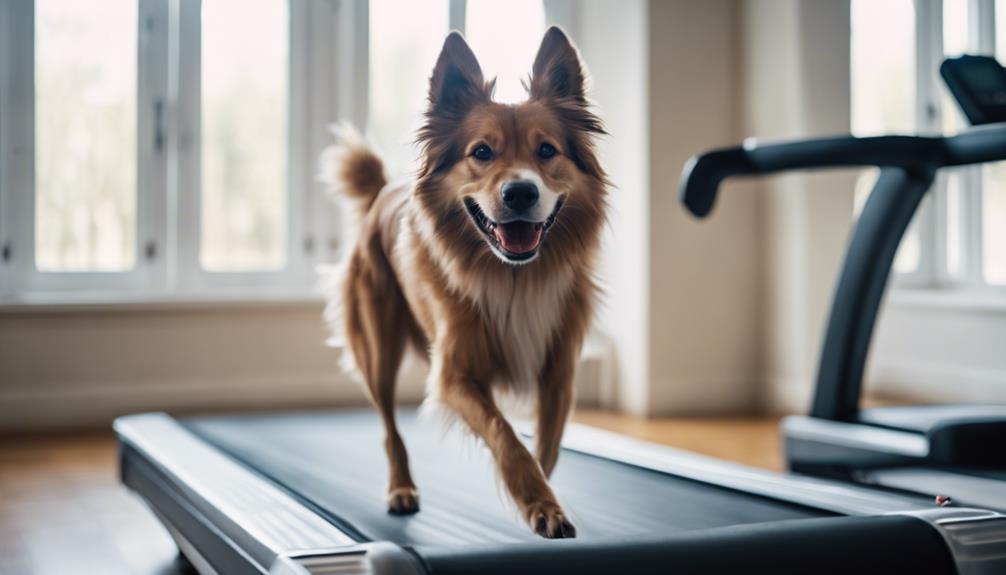
Why is treadmill exercise beneficial for dogs in various situations and circumstances?
Treadmill exercise offers a controlled environment for dogs to engage in physical activity, making it ideal during extreme weather conditions or for dogs requiring rehabilitation. It provides a consistent surface for walking or running, promoting cardiovascular health and muscle strength.
Treadmill workouts can help in managing weight, improving endurance, and enhancing overall fitness levels. Additionally, treadmill training allows for customization of speed and duration, catering to individual fitness goals and limitations.
Preparing Your Dog for Treadmill Training
When introducing your dog to treadmill training, establishing a gradual and positive approach is key to ensuring a smooth transition into this form of exercise.
Begin by familiarizing your dog with the treadmill while it is stationary, using treats and praise to create a positive association.
Slowly introduce movement by starting the treadmill at the lowest speed to prevent startling your dog.
Monitor your dog's body language for signs of fear or discomfort, and adjust the training pace accordingly.
Keep sessions short initially, gradually increasing both speed and duration as your dog becomes more comfortable.
Remember to always prioritize your dog's safety and well-being throughout the training process.
Factors to Consider Before Starting
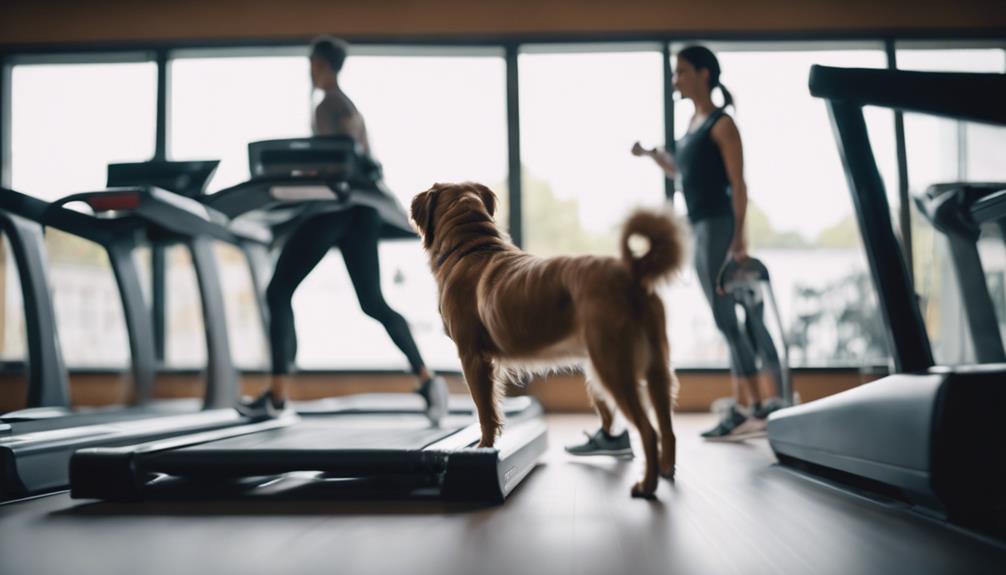
Before initiating treadmill training for your dog, carefully evaluate the suitability of this exercise based on your dog's physical condition and temperament. Consider the following factors before starting:
- Health Assessment: Ensure your dog is healthy and free from any physical conditions that may be aggravated by treadmill exercise.
- Behavioral Evaluation: Assess your dog's temperament and comfort level with new experiences to determine if treadmill training is suitable.
- Training Readiness: Confirm that your dog is responsive to basic commands and positive reinforcement techniques, which are essential for a successful treadmill training experience.
Introducing Your Dog to the Treadmill
To acquaint your dog with treadmill usage, focus on creating a positive and gradual introduction to the equipment. Begin by allowing your dog to explore the treadmill while it is turned off, using treats and positive reinforcement to create a positive association.
Once your dog is comfortable standing on the stationary belt, start the treadmill at the slowest setting to prevent any sudden movements that might startle your pet. Gradually increase the speed as your dog becomes more accustomed to the motion.
It's essential to closely monitor your dog's body language and reactions throughout the introduction process to ensure their safety and comfort. By taking the time to introduce the treadmill slowly and positively, you can help your dog adjust to this new form of exercise effectively.
Setting the Right Pace for Treadmill Workouts
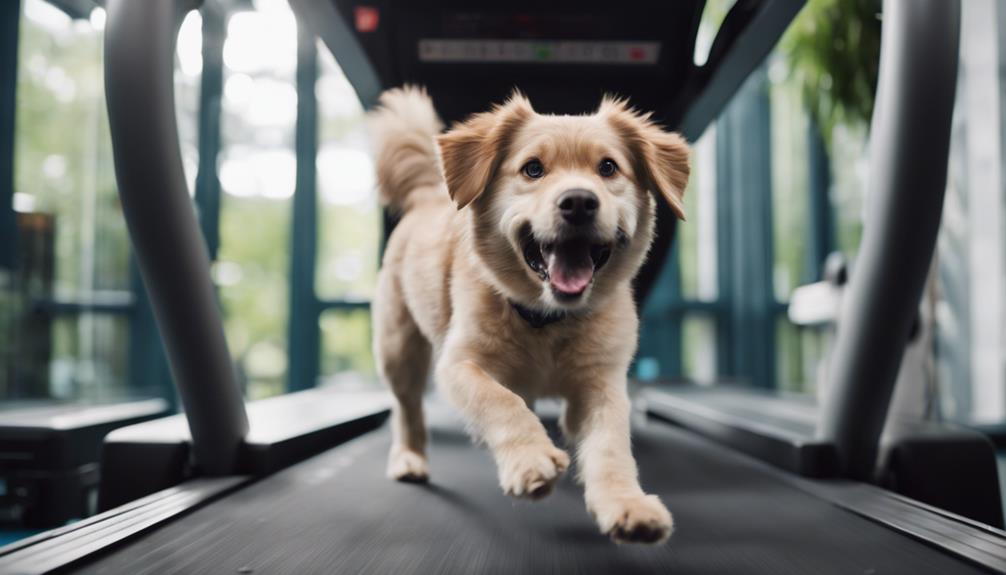
Determining the optimal pace for treadmill workouts for dogs involves careful consideration of their physical capabilities and comfort levels. When setting the pace for your dog's treadmill session, keep in mind the following:
- Start Slow: Begin at a pace that is comfortable for your dog, allowing them to adapt gradually to the movement of the treadmill.
- Monitor Body Language: Watch for signs of stress or discomfort such as reluctance to move or excessive panting, and adjust the speed accordingly.
- Gradual Progression: Increase the speed incrementally as your dog becomes more accustomed to the treadmill, ensuring a safe and effective workout.
Monitoring Your Dog's Treadmill Session
During your dog's treadmill session, vigilantly observe for any signs of fatigue or discomfort to ensure a safe and effective workout. Keep a close eye on your dog's body language, such as excessive panting, slowing down, or reluctance to continue.
If you notice any of these signs, stop the treadmill immediately and allow your dog to rest. Monitoring your dog's treadmill session is crucial to prevent overexertion and potential injuries.
Remember to stay attentive throughout the entire workout, adjusting the pace or stopping the session if necessary. By actively supervising your dog's treadmill activity, you can ensure a positive experience and promote their overall well-being.
Using Positive Reinforcement Techniques
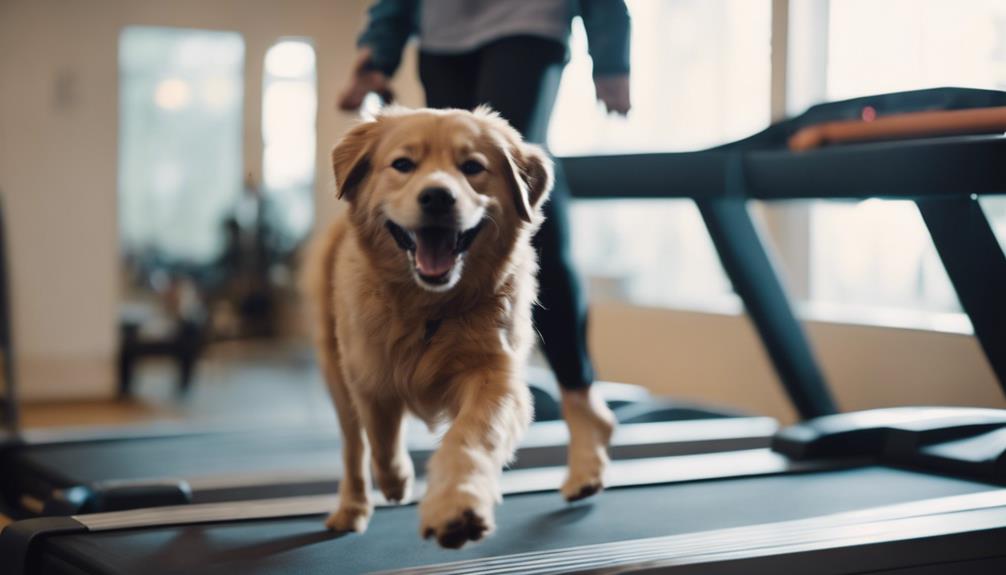
When monitoring your dog's treadmill session for signs of fatigue or discomfort, employing positive reinforcement techniques can enhance the overall training experience and encourage desired behavior. Positive reinforcement involves rewarding your dog for exhibiting the desired behavior, making them more likely to repeat it in the future.
Here are three effective positive reinforcement techniques for treadmill training:
- Use treats: Reward your dog with treats when they step onto the treadmill or walk/run correctly.
- Verbal praise: Offer verbal praise in a cheerful tone to reinforce good behavior during treadmill sessions.
- Toys: Introduce their favorite toy as a reward for completing a successful treadmill workout.
Overcoming Fear of Treadmill Training
To help your dog overcome fear of treadmill training, establishing a gradual and positive introduction to the equipment is crucial. Begin by allowing the dog to explore the treadmill while it is stationary, using treats and praise to create a positive association.
Once the dog is comfortable, start the treadmill at the slowest speed to prevent startling the pet. Progress slowly, increasing speed and duration as the dog becomes more confident. Monitor the dog's body language for signs of fear or stress, and be prepared to pause or stop the treadmill if needed.
Consistent positive reinforcement and patience are key to helping your dog conquer its fear of treadmill training.
Structuring a Treadmill Workout Routine
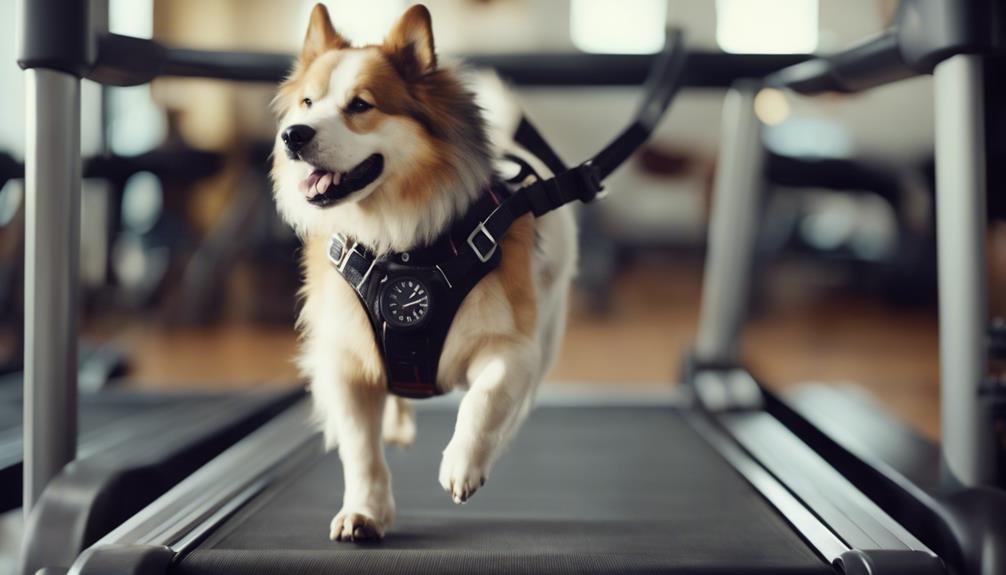
Crafting a well-structured treadmill workout routine for your dog involves careful planning and consideration of their fitness levels and exercise needs. To ensure an effective workout session, follow these steps:
- Warm-Up Phase: Begin the session with a gentle warm-up to prepare your dog's muscles for exercise and reduce the risk of injury.
- Main Workout Phase: Gradually increase the speed and intensity of the treadmill to match your dog's fitness level, allowing them to walk, trot, or run according to their capability.
- Cool-Down Phase: Conclude the workout with a slower pace to help your dog recover and prevent muscle stiffness post-exercise.
Ensuring Safety During Treadmill Sessions
During treadmill sessions with dogs, prioritizing safety measures is paramount to prevent any potential risks or injuries. It is crucial to ensure the dog's well-being and comfort throughout the workout. Here are some safety measures to consider during treadmill sessions:
| Safety Measures | Description |
|---|---|
| Supervision | Always supervise the dog while on the treadmill. |
| Signs of Fatigue | Watch for panting or fatigue; stop if signs appear. |
| Immediate Response | Slow down or stop the treadmill if the dog shows exhaustion. |
Recognizing Signs of Overexertion
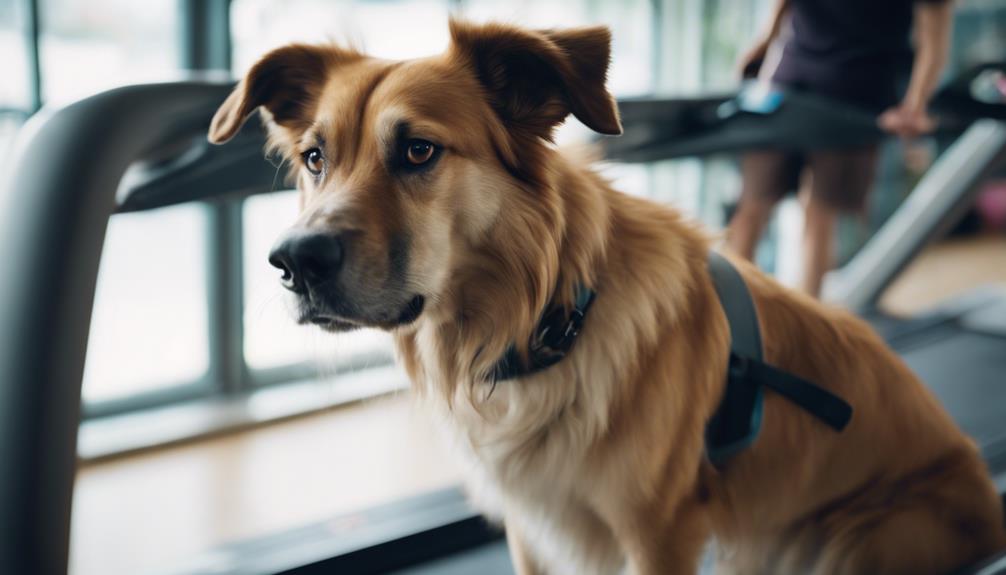
When training dogs on treadmills, it is essential to be vigilant for signs of overexertion to ensure their safety and well-being. Recognizing these signs promptly can prevent potential injuries and discomfort for the dog.
Here are some key indicators of overexertion to watch out for:
- Excessive Panting: If the dog is panting heavily and struggling to catch its breath, it may be a sign of overexertion.
- Lagging Behind: If the dog starts lagging or slowing down significantly during the treadmill session, it could indicate fatigue.
- Stumbling or Unsteady Gait: Observing the dog for any signs of stumbling, unsteadiness, or difficulty in maintaining proper form on the treadmill can signal exhaustion.
Monitoring these signs closely will help ensure a safe and effective treadmill workout for your canine companion.
Alternatives to Treadmill Exercise
Exploring alternative exercise options can provide dogs with engaging physical activities beyond treadmill workouts. One effective alternative is engaging in interactive games that promote physical activity. Additionally, swimming can be an excellent low-impact exercise, especially for small dog breeds. Another alternative is agility training, which not only provides physical exercise but also mental stimulation for the dog. Finally, incorporating indoor obstacle courses using agility equipment can be a fun and challenging way to keep your dog active. Below is a table highlighting these alternative exercise options:
| Alternative Exercise Options | Benefits |
|---|---|
| Interactive Games | Promotes physical activity |
| Swimming | Low-impact exercise |
| Agility Training | Physical and mental stimulation |
| Indoor Obstacle Courses | Fun and challenging activity |
Indoor Activities for Physical Engagement
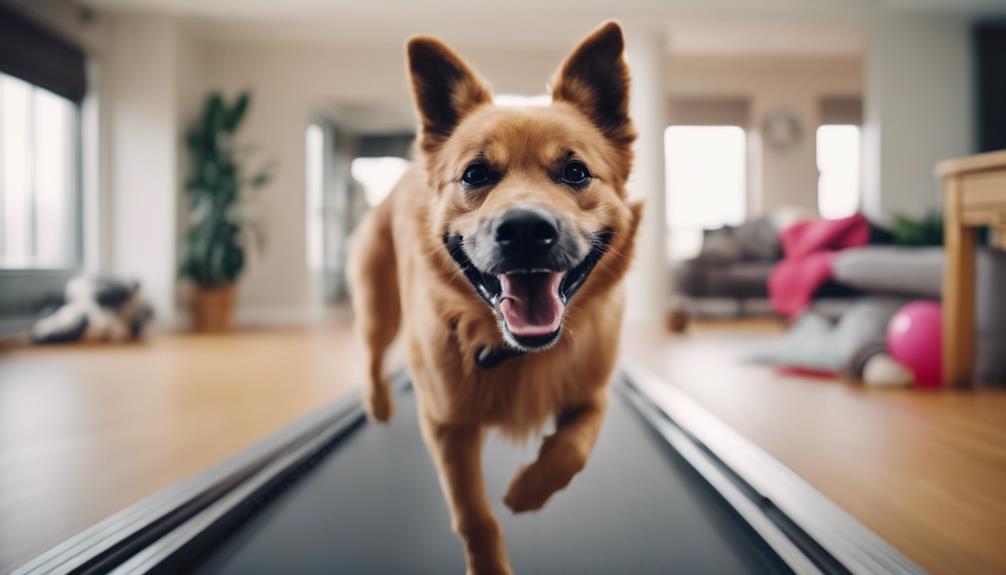
To provide dogs with engaging physical activities indoors, one effective approach is to incorporate interactive games that promote both physical exercise and mental stimulation.
Indoor Activities for Physical Engagement:
- Hide and Seek: Hide treats or toys around the house for the dog to find, encouraging movement and mental engagement.
- Obstacle Course: Set up a mini obstacle course using household items like chairs or tunnels to stimulate agility and coordination.
- Tug of War: Engage in a game of tug of war with a rope toy to provide a fun and physically stimulating activity for the dog.
These activities can help keep dogs active and entertained while indoors, contributing to their overall well-being.
Tailoring Exercise to Your Dog's Needs
Tailoring exercise routines to suit your dog's specific physical abilities and health requirements is essential for promoting their overall well-being and fitness levels. Each dog is unique, with varying energy levels, breed characteristics, age, and health conditions that influence their exercise needs.
For example, high-energy breeds like Border Collies may require more vigorous and interactive activities to stay mentally and physically stimulated, while senior dogs may benefit from low-impact exercises like gentle walks or swimming to maintain their mobility without straining joints.
Consulting with a veterinarian or professional trainer can help determine the most suitable exercise regimen for your dog. By customizing workouts to meet your dog's individual requirements, you can ensure they remain healthy, happy, and active.
Prioritizing Canine Well-being in Fitness
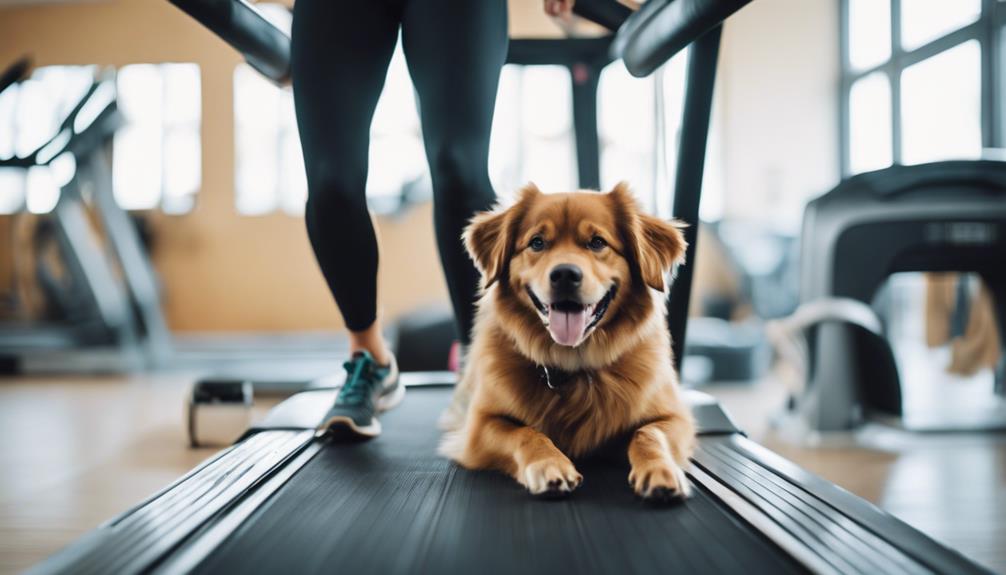
Prioritizing the well-being of canines in fitness routines is paramount for ensuring their health and happiness.
- Proper Warm-up and Cool-down: Begin each exercise session with a gentle warm-up to prepare your dog's muscles and end with a cool-down period to prevent strain or injury.
- Regular Hydration Breaks: Provide frequent water breaks during workouts to keep your dog hydrated and prevent overheating.
- Monitoring Signs of Discomfort: Watch for any signs of distress, such as limping, excessive panting, or reluctance to continue, and adjust the workout accordingly to prevent any potential harm.
Conclusion
In conclusion, treadmill exercise can be a beneficial form of physical activity for dogs when introduced appropriately and with consideration for their individual needs. By following the outlined factors to consider, training process, and safety measures, you can ensure a positive experience for your canine companion.
Additionally, exploring alternative exercise options and tailoring activities to your dog's preferences can further enhance their overall well-being and fitness. Prioritizing your dog's health and happiness in their exercise routine is essential for a harmonious relationship.




